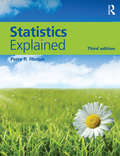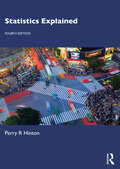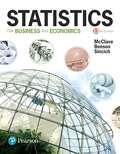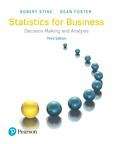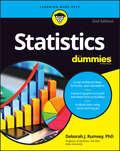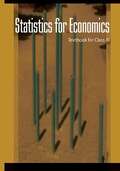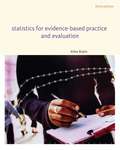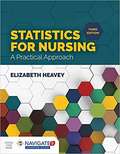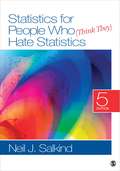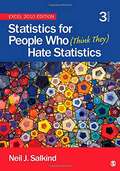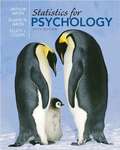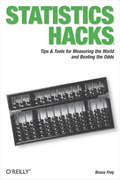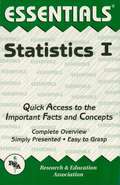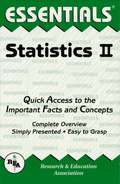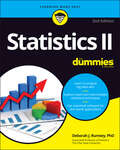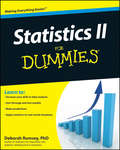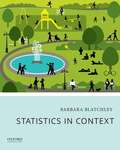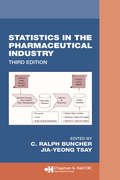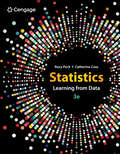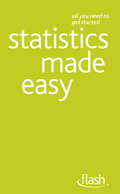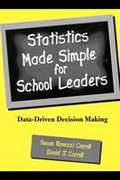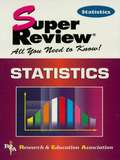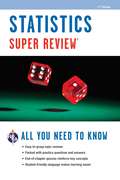- Table View
- List View
Statistics Explained
by Perry R. HintonStatistics Explained is an accessible introduction to statistical concepts and ideas. It makes few assumptions about the reader’s statistical knowledge, carefully explaining each step of the analysis and the logic behind it. The book: provides a clear explanation of statistical analysis and the key statistical tests employed in analysing research data gives accessible explanations of how and why statistical tests are used includes a wide range of practical, easy-to-understand worked examples. Building on the international success of earlier editions, this fully updated revision includes developments in statistical analysis, with new sections explaining concepts such as bootstrapping and structural equation modelling. A new chapter - ‘Samples and Statistical Inference’ - explains how data can be analysed in detail to examine its suitability for certain statistical tests. The friendly and straightforward style of the text makes it accessible to all those new to statistics, as well as more experienced students requiring a concise guide. It is suitable for students and new researchers in disciplines including Psychology, Education, Sociology, Sports Science, Nursing, Communication, and Media and Business Studies. Presented in full colour and with an updated, reader-friendly layout, this new edition also comes with a companion website featuring supplementary resources for students. Unobtrusive cross-referencing makes it the ideal companion to Perry R. Hinton’s SPSS Explained, also published by Routledge. Perry R. Hinton has many years of experience in teaching statistics to students from a wide range of disciplines and his understanding of the problems students face forms the basis of this book.
Statistics Explained
by Perry R. HintonStatistics Explained, now in its fully revised Fourth Edition, is for students and researchers who wish to understand the statistical analyses used to analyse quantitative (numerical) research data in a wide range of academic disciplines, in particular, the behavioural, human and social sciences.This book explains, in a clear and informative manner, the logic of statistical analysis, in particular the null hypothesis significance testing (NHST) method. Using this method, a range of statistical tests have been devised for different types of data. Each of these tests is explained in the book by adopting a step-by-step (“walkthrough”) approach with a specific illustrative example. Crucially, these explanations do not require the reader to have an advanced knowledge of mathematics or statistics, but only assumes the basic mathematics which most readers will have learnt at high school. The book also examines the criticisms of NHST and introduces the reader to Bayesian statistics. As a result the reader will be able to critically evaluate the outcomes of statistical analysis both of their own work and that of others.Statistics Explains will be of great interest to students and researchers in the behavioural, human and social sciences in understanding both the outcomes of their own research and also the research reports in the academic journals.
Statistics Explained
by Steve MckillupAn understanding of statistics and experimental design is essential for life science studies, but many students lack a mathematical background and some even dread taking an introductory statistics course. Using a refreshingly clear and encouraging reader-friendly approach, this book helps students understand how to choose, carry out, interpret and report the results of complex statistical analyses, critically evaluate the design of experiments and proceed to more advanced material. Taking a straightforward conceptual approach, it is specifically designed to foster understanding, demystify difficult concepts and encourage the unsure. Even complex topics are explained clearly, using a pictorial approach with a minimum of formulae and terminology. Examples of tests included throughout are kept simple by using small data sets. In addition, end-of-chapter exercises, new to this edition, allow self-testing. Handy diagnostic tables help students choose the right test for their work and remain a useful refresher tool for postgraduates.
Statistics For Business And Economics
by Terry Sincich P. George Benson James McClaveThirteenth Edition, Statistics for Business and Economics introduces statistics in the context of contemporary business. Emphasizing statistical literacy in thinking, the text applies its concepts with real data and uses technology to develop a deeper conceptual understanding. Examples, activities, and case studies foster active learning while emphasizing intuitive concepts of probability and teaching readers to make informed business decisions. The Thirteenth Edition continues to highlight the importance of ethical behavior in collecting, interpreting, and reporting on data, while also providing a wealth of new and updated exercises and case studies.
Statistics For Business: Decision Making And Analysis
by Robert A. Stine Dean P. FosterUnderstand Business. Understand Data. The 3rd Edition of Statistics for Business: Decision Making and Analysis emphasizes an application-based approach, in which readers learn how to work with data to make decisions. In this contemporary presentation of business statistics, readers learn how to approach business decisions through a 4M Analytics decision making strategy—motivation, method, mechanics and message—to better understand how a business context motivates the statistical process and how the results inform a course of action. Each chapter includes hints on using Excel, Minitab Express, and JMP for calculations, pointing the reader in the right direction to get started with analysis of data.
Statistics For Dummies
by Deborah J. RumseyThe fun and easy way to get down to business with statisticsStymied by statistics? No fear ? this friendly guide offers clear, practical explanations of statistical ideas, techniques, formulas, and calculations, with lots of examples that show you how these concepts apply to your everyday life.Statistics For Dummies shows you how to interpret and critique graphs and charts, determine the odds with probability, guesstimate with confidence using confidence intervals, set up and carry out a hypothesis test, compute statistical formulas, and more.Tracks to a typical first semester statistics courseUpdated examples resonate with today's studentsExplanations mirror teaching methods and classroom protocolPacked with practical advice and real-world problems, Statistics For Dummies gives you everything you need to analyze and interpret data for improved classroom or on-the-job performance.
Statistics For Economics class 11 - NCERT - 23
by National Council of Educational Research and TrainingThe "STATISTICS FOR ECONOMICS" textbook by NCERT for Class XI is an essential guide for students venturing into the realm of economic data analysis. This resource demystifies the complex world of statistics, making it accessible for budding economists. Beginning with an introduction to the significance of statistics in economics, it delves into the techniques of data collection, organization, and presentation. The textbook elucidates central tendencies, dispersions, and correlations, highlighting their relevance in economic scenarios. Students are also introduced to index numbers and their applications in economic data interpretation. Special attention is given to the use of graphical and tabular methods for data presentation, providing students with practical tools to understand and analyze economic trends. By the end of the book, students are well-equipped with foundational statistical concepts, tailored specifically for economic applications, preparing them for advanced studies and real-world economic data analysis.
Statistics For Evidence-Based Practice And Evaluation
by Allen RubinBoth practical and easy to read, Rubin's STATISTICS FOR EVIDENCE-BASED PRACTICE AND EVALUATION provides you with a step-by-step guide that will help you succeed in your course. Practice illustrations and exercises support your ability to study and retain core concepts, while practical examples provide you with the opportunity to see how and when data analysis and statistics are used by helping professionals in the real world.
Statistics For Nursing: A Practical Approach
by Elizabeth HeaveyEach new print copy includes Navigate 2 Advantage Access that unlocks a comprehensive and interactive eBook, student practice activities and assessments, a full suite of instructor resources, and learning analytics reporting tools. Statistics for Nursing: A Practical Approach, Third Edition is designed in accordance with the Conversation Theory of Gordon Pask and presents the complicated topic of statistics in an understandable manner for entry level nurses. The underlying principle of this design is to give students the opportunity to practice statistics while they learn statistics. The text accomplishes this through the inclusion of relevant clinical examples followed by end of chapter application exercises. The Third Edition has been updated with practice activities which enable students to apply the content they have learned. In addition, the authors have included new research articles to develop and reinforce literature critiquing skills. These new features provide more opportunities for students to apply the concepts learned while the explanations are beneficial to clinical experts interested in further developing evidence-based skills. This text meets the needs of both undergraduate nursing research students who need to learn how to critically analyze literature as well as graduate DNP students who must also be familiar with statistics for nursing in accordance with the rigor of the DNP program. New to the Third Edition: • Additional review questions • New and updated graphs and figures • Updated lesson content for computer application exercises
Statistics For People Who (Think They) Hate Statistics (Fifth Edition)
by Neil J. SalkindThe best-selling Statistics for People Who (Think They) Hate Statistics is now in its Fifth Edition Continuing its hallmark use of humor and common sense, this text helps students develop an understanding of an often intimidating and difficult subject with an approach that is informative, personable, and clear. Author Neil J. Salkind takes students through various statistical procedures, beginning with a brief historical introduction to statistics, correlation and graphical representation of data, and ending with inferential techniques and analysis of variance. The book provides examples using SPSS and includes reviews of measurement topics, such as reliability, validity, and also introductory non-parametric statistics. With more examples than ever before, the new edition offers a new Real World Stats feature at the end of each chapter. In addition, an enhanced interactive eBook edition (available spring 2014) features animated chapter introductions, quick quizzes, video clips, and more The Fifth Edition is also the basis for the Excel edition for the book of the same name
Statistics For People Who (Think They) Hate Statistics: Excel 2010 Edition
by Neil J. SalkindThe bestselling text Statistics for People Who (Think They) Hate Statistics is the basis for this completely adapted Excel 2010 version. Author Neil J. Salkind presents an often intimidating and difficult subject in a way that is informative, personable, and clear. Researchers and students who find themselves uncomfortable with the analysis portion of their work will appreciate this book′s unhurried pace and thorough, friendly presentation. Salkind begins the Excel version with a complete introduction to the software, and shows the students how to install the Excel Analysis ToolPak option (free) to earn access to a host of new and very useful analytical techniques. He then walks students through various statistical procedures, beginning with correlations and graphical representation of data and ending with inferential techniques and analysis of variance. Pedagogical features include sidebars offering additional technical information about the topic and set-off points that reinforce major themes. Finally, questions to chapter exercises, a complete glossary, and extensive Excel functionality are located at the back of the book. This Third Edition is updated for use with Excel 2010.
Statistics For Psychology
by Elaine Aron Arthur Aron Elliot CoupsThis author team is committed to making statistics a highlight for psychology students! Now, in a 5th edition, Statistics for Psychology, continues to be an accessible, current, and interesting approach to statistics. With each revision, the authors have maintain those things about the book that have been especially appreciated, while reworking the text to take into account the feedback, their our own experiences, and advances and changes in the field. The fifth edition of this popular text uses definitional formulas to emphasize concepts of statistics, rather than rote memorization. This approach constantly reminds students of the logic behind what they are learning, and each procedure is taught both verbally and numerically, which helps to emphasize the concepts. Thoroughly revised, with new content and many new practice examples, this text takes the reader from basic procedures through analysis of variance (ANOVA). While learning statistics, students also learn how to read and interpret current research.
Statistics Hacks: Tips & Tools for Measuring the World and Beating the Odds
by Bruce FreyWant to calculate the probability that an event will happen? Be able to spot fake data? Prove beyond doubt whether one thing causes another? Or learn to be a better gambler? You can do that and much more with 75 practical and fun hacks packed into Statistics Hacks. These cool tips, tricks, and mind-boggling solutions from the world of statistics, measurement, and research methods will not only amaze and entertain you, but will give you an advantage in several real-world situations-including business.This book is ideal for anyone who likes puzzles, brainteasers, games, gambling, magic tricks, and those who want to apply math and science to everyday circumstances. Several hacks in the first chapter alone-such as the "central limit theorem,", which allows you to know everything by knowing just a little-serve as sound approaches for marketing and other business objectives. Using the tools of inferential statistics, you can understand the way probability works, discover relationships, predict events with uncanny accuracy, and even make a little money with a well-placed wager here and there.Statistics Hacks presents useful techniques from statistics, educational and psychological measurement, and experimental research to help you solve a variety of problems in business, games, and life. You'll learn how to:Play smart when you play Texas Hold 'Em, blackjack, roulette, dice games, or even the lotteryDesign your own winnable bar bets to make money and amaze your friendsPredict the outcomes of baseball games, know when to "go for two" in football, and anticipate the winners of other sporting events with surprising accuracyDemystify amazing coincidences and distinguish the truly random from the only seemingly random--even keep your iPod's "random" shuffle honestSpot fraudulent data, detect plagiarism, and break codesHow to isolate the effects of observation on the thing observedWhether you're a statistics enthusiast who does calculations in your sleep or a civilian who is entertained by clever solutions to interesting problems, Statistics Hacks has tools to give you an edge over the world's slim odds.
Statistics I Essentials
by Emil G. MilewskiREA's Essentials provide quick and easy access to critical information in a variety of different fields, ranging from the most basic to the most advanced. As its name implies, these concise, comprehensive study guides summarize the essentials of the field covered. Essentials are helpful when preparing for exams, doing homework and will remain a lasting reference source for students, teachers, and professionals. Statistics I covers include frequency distributions, numerical methods of describing data, measures of variability, parameters of distributions, probability theory, and distributions.
Statistics II Essentials
by Emil MilewskiREA's Essentials provide quick and easy access to critical information in a variety of different fields, ranging from the most basic to the most advanced. As its name implies, these concise, comprehensive study guides summarize the essentials of the field covered. Essentials are helpful when preparing for exams, doing homework and will remain a lasting reference source for students, teachers, and professionals. Statistics II discusses sampling theory, statistical inference, independent and dependent variables, correlation theory, experimental design, count data, chi-square test, and time series.
Statistics II For Dummies
by Deborah J. RumseyContinue your statistics journey with this all-encompassing reference Completed Statistics through standard deviations, confidence intervals, and hypothesis testing? Then you’re ready for the next step: Statistics II. And there’s no better way to tackle this challenging subject than with Statistics II For Dummies! Get a brief overview of Statistics I in case you need to brush up on earlier topics, and then dive into a full explanation of all Statistic II concepts, including multiple regression, analysis of variance (ANOVA), Chi-square tests, nonparametric procedures, and analyzing large data sets. By the end of the book, you’ll know how to use all the statistics tools together to create a great story about your data. For each Statistics II technique in the book, you get an overview of when and why it’s used, how to know when you need it, step-by-step directions on how to do it, and tips and tricks for working through the solution. You also find: What makes each technique distinct and what the results say How to apply techniques in real life An interpretation of the computer output for data analysis purposes Instructions for using Minitab to work through many of the calculations Practice with a lot of examples With Statistics II For Dummies, you will find even more techniques to analyze a set of data. Get a head start on your Statistics II class, or use this in conjunction with your textbook to help you thrive in statistics!
Statistics II for Dummies
by Deborah J. RumseyThe ideal supplement and study guide for students preparing for advanced statisticsPacked with fresh and practical examples appropriate for a range of degree-seeking students, Statistics II For Dummies helps any reader succeed in an upper-level statistics course. It picks up with data analysis where Statistics For Dummies left off, featuring new and updated examples, real-world applications, and test-taking strategies for success. This easy-to-understand guide covers such key topics as sorting and testing models, using regression to make predictions, performing variance analysis (ANOVA), drawing test conclusions with chi-squares, and making comparisons with the Rank Sum Test.
Statistics In Context
by Barbara BlatchleyStatistics in Context offers a fresh approach to teaching statistics. Designed to reduce students' fear of numbers, the text aims to put statistics-wary readers at ease with uncomplicated explanations and practical examples drawn from real research and everyday life. Written in lively, accessible prose, the narrative describes the who, what, when, where, and why, and also the how, of statistics. DISTINCTIVE FEATURES * "Everyday Statistics" boxes examine practical applications and relate them to the themes of the chapter * "The Historical Context" features tell the story of how different statistical procedures developed * "CheckPoint "exercises give students the chance to review the material and assess their understanding at the end of each section * "Think About It" boxes challenge students to apply what they have learned to a difficult problem * A variety of figures, tables, and worked examples guide students step by step through the calculations described in the text * Abundant end-of-chapter practice problems give students many opportunities to test their mastery of the procedures described in the text * The "Using Statistical Software" supplement teaches students how to perform statistical analysis using either SPSS or R
Statistics In the Pharmaceutical Industry (Chapman & Hall/CRC Biostatistics Series)
by C. Ralph Buncher Jia-Yeong TsayThe growth of the pharmaceutical industry over the past decade is astounding, but the impact of this growth on statistics is somewhat confusing. While software has made analysis easier and more efficient, regulatory bodies now demand deeper and more complex analyses, and pharmacogenetic/genomic studies serve up an entirely new set of challenges. For more than two decades, Statistics in the Pharmaceutical Industry has been the definitive guide to sorting through the challenges in the industry, and this Third Edition continues that tradition.Updated and expanded to reflect the most recent trends and developments in the field, Statistics in the Pharmaceutical Industry, Third Edition presents chapters written by experts from both regulatory agencies and pharmaceutical companies who discuss everything from experimental design to post-marketing studies. This approach sheds light on what regulators consider acceptable methodologies and what methods have proven successful for industrial statisticians. Both new and revised chapters reflect the increasingly global nature of the industry as represented by authors from Japan and Europe, the increasing trend toward non-inferiority/equivalence testing, adaptive design in clinical trials, global harmonization of regulatory standards, and multiple comparison studies. The book also examines the latest considerations in anti-cancer studies. Statistics in the Pharmaceutical Industry, Third Edition demystifies the approval process by combining regulatory and industrial points of view, making it a must-read for anyone performing statistical analysis at any point in the drug approval process.
Statistics Learning from Data
by Roxy Peck Catherine CaseGuide students to success in statistics with the innovative approach in Peck/Case's STATISTICS: LEARNING FROM DATA, 3rd Edition. This edition addresses common obstacles to learning, as the authors translate research on student learning in statistics and probability into practice. The authors use proven methods to address areas where students struggle most -- probability, hypothesis testing and selecting an appropriate method of analysis. Students strengthen their conceptual understanding and procedural fluency as they put knowledge into practice with updated learning objectives, real-data examples, exercises and technology notes. WebAssign digital resources and Cengage's Statistical Analysis and Learning Tool (SALT) are also available to help transform introductory-level students into statistical thinkers.
Statistics Made Easy: Flash
by Alan GrahamThe books in this bite-sized new series contain no complicated techniques or tricky materials, making them ideal for the busy, the time-pressured or the merely curious. Statistics Made Easy is a short, simple and to-the-point guide to statistics. In just 96 pages, the reader will learn all about why we do the things we do. Ideal for the busy, the time-pressured or the merely curious, Statistics Made Easy is a quick, no-effort way to break into this fascinating topic.
Statistics Made Easy: Flash
by Alan GrahamThe books in this bite-sized new series contain no complicated techniques or tricky materials, making them ideal for the busy, the time-pressured or the merely curious. Statistics Made Easy is a short, simple and to-the-point guide to statistics. In just 96 pages, the reader will learn all about why we do the things we do. Ideal for the busy, the time-pressured or the merely curious, Statistics Made Easy is a quick, no-effort way to break into this fascinating topic.
Statistics Made Simple For School Leaders: Data-Driven Decision Making
by David J. Carroll Susan Rovezzi CarrollThe chief executive officer of a corporation is not much different from a public school administrator. While CEOs base many of their decisions on data, for school administrators, this type of research may conjure up miserable memories of searching for information to meet a graduate school requirement. However, the value of data-based decision making will continue to escalate and the school community--students, teachers, parents and the general public--expect this information to come from their administrators. Administrators are called on to be accountable, but few are capable of presenting the mountain of data that they collect in a cohesive and strategic manner. Most statistical books are focused on statistical theory versus application, but Statistics Made Simple for School Leaders presents statistics in a simple, practical, conceptual, and immediately applicable manner. It enables administrators to take their data and manage it into strategic information so the results can be used for action plans that benefit the school system. The approach is "user friendly" and leaves the reader with a confident can-do attitude to communicate results and plans to staff and the community.
Statistics Super Review
by Statistics Study GuidesGet all you need to know with Super Reviews! Each Super Review is packed with in-depth, student-friendly topic reviews that fully explain everything about the subject. The Statistics Super Review includes frequency distributions, numerical methods of describing data, measures of variability, probability, distributions, sampling theory, statistical inference, general linear model inferences, experimental design, the chi-square test, and time series. Take the Super Review quizzes to see how much you've learned - and where you need more study. Makes an excellent study aid and textbook companion. Great for self-study! DETAILS - From cover to cover, each in-depth topic review is easy-to-follow and easy-to-grasp - Perfect when preparing for homework, quizzes, and exams! - Review questions after each topic that highlight and reinforce key areas and concepts - Student-friendly language for easy reading and comprehension - Includes quizzes that test your understanding of the subject
Statistics Super Review, 2nd Ed.
by The Editors of REANeed help with Statistics? Want a quick review or refresher for class? This is the book for you! REA's Statistics Super Review gives you everything you need to know!This Super Review can be used as a supplement to your high school or college textbook, or as a handy guide for anyone who needs a fast review of the subject.* Comprehensive, yet concise coverage - review covers the material that students must know about statistics. Each topic is presented in a clear and easy-to-understand format that makes learning easier.* Questions and answers for each topic - let you practice what you've learned and build your statistics skills.* End-of-chapter quizzes - gauge your understanding of the important information you need to know, so you'll be ready for any homework assignment, quiz, or test.Whether you need a quick refresher on the subject, or are prepping for your next exam, we think you'll agree that REA's Super Review provides all you need to know!
